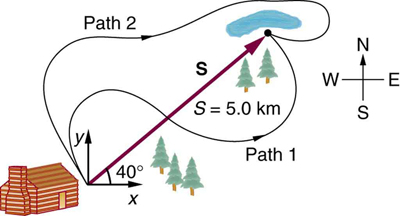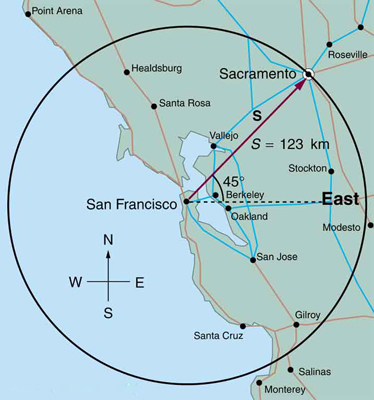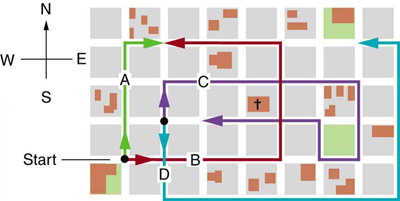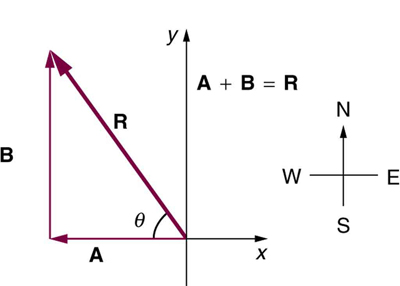| << Chapter < Page | Chapter >> Page > |
If we decided to walk three times as far on the first leg of the trip considered in the preceding example, then we would walk , or 82.5 m, in a direction north of east. This is an example of multiplying a vector by a positive scalar . Notice that the magnitude changes, but the direction stays the same.
If the scalar is negative, then multiplying a vector by it changes the vector’s magnitude and gives the new vector the opposite direction. For example, if you multiply by –2, the magnitude doubles but the direction changes. We can summarize these rules in the following way: When vector is multiplied by a scalar ,
In our case, and . Vectors are multiplied by scalars in many situations. Note that division is the inverse of multiplication. For example, dividing by 2 is the same as multiplying by the value (1/2). The rules for multiplication of vectors by scalars are the same for division; simply treat the divisor as a scalar between 0 and 1.
In the examples above, we have been adding vectors to determine the resultant vector. In many cases, however, we will need to do the opposite. We will need to take a single vector and find what other vectors added together produce it. In most cases, this involves determining the perpendicular components of a single vector, for example the x - and y -components, or the north-south and east-west components.
For example, we may know that the total displacement of a person walking in a city is 10.3 blocks in a direction north of east and want to find out how many blocks east and north had to be walked. This method is called finding the components (or parts) of the displacement in the east and north directions, and it is the inverse of the process followed to find the total displacement. It is one example of finding the components of a vector. There are many applications in physics where this is a useful thing to do. We will see this soon in Projectile Motion , and much more when we cover forces in Dynamics: Newton’s Laws of Motion . Most of these involve finding components along perpendicular axes (such as north and east), so that right triangles are involved. The analytical techniques presented in Vector Addition and Subtraction: Analytical Methods are ideal for finding vector components.
What do vectors and scalars have in common? How do they differ?
Two campers in a national park hike from their cabin to the same spot on a lake, each taking a different path, as illustrated below. The total distance traveled along Path 1 is 7.5 km, and that along Path 2 is 8.2 km. What is the final displacement of each camper?

If an airplane pilot is told to fly 123 km in a straight line to get from San Francisco to Sacramento, explain why he could end up anywhere on the circle shown in [link] . What other information would he need to get to Sacramento?

Suppose you take two steps and (that is, two nonzero displacements). Under what circumstances can you end up at your starting point? More generally, under what circumstances can two nonzero vectors add to give zero? Is the maximum distance you can end up from the starting point the sum of the lengths of the two steps?
Explain why it is not possible to add a scalar to a vector.
If you take two steps of different sizes, can you end up at your starting point? More generally, can two vectors with different magnitudes ever add to zero? Can three or more?
Use graphical methods to solve these problems. You may assume data taken from graphs is accurate to three digits.
Find the following for path A in [link] : (a) the total distance traveled, and (b) the magnitude and direction of the displacement from start to finish.

(a)
(b) , east of north
Suppose you walk 18.0 m straight west and then 25.0 m straight north. How far are you from your starting point, and what is the compass direction of a line connecting your starting point to your final position? (If you represent the two legs of the walk as vector displacements and , as in [link] , then this problem asks you to find their sum .)

Suppose you first walk 12.0 m in a direction west of north and then 20.0 m in a direction south of west. How far are you from your starting point, and what is the compass direction of a line connecting your starting point to your final position? (If you represent the two legs of the walk as vector displacements and , as in [link] , then this problem finds their sum .)

, south of west
Repeat the problem above, but reverse the order of the two legs of the walk; show that you get the same final result. That is, you first walk leg , which is 20.0 m in a direction exactly south of west, and then leg , which is 12.0 m in a direction exactly west of north. (This problem shows that .)

Notification Switch
Would you like to follow the '2d kinematics' conversation and receive update notifications?